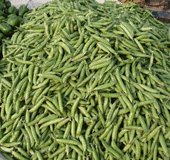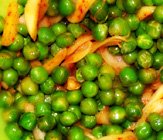Table of Contents
Selection and storage

|
| Fresh green peas in a market. |
Green peas are winter crops. Fresh peas can be readily available from December until April in the farmer markets. However, cold-stored packs, dry peas, mature seeds, and split peas, flour, etc., can be found in groceries around the year.
While shopping for green peas looks for fresh pods that are full, heavy, and brimming with seeds. Avoid those with wrinkled skin or over-mature yellow pods.
Green peas are at their best soon after harvest since much of their sugar content rapidly converts into starch. To store, place them inside a vegetable container in the home refrigerator set at high relative humidity where they keep fresh for 2-3 days. Frozen seeds, however, can be used for several months.
Preparation and serving methods

|
| Green peas sauteed with oil. garlic, onion. Courtesy: Old Fashin’d. |
Trim away stalk end and peel its thin thread along the suture line. Split open its outer husk to release round to oval, green seeds.
Here are some serving tips:
-
Peas mix well with other complementing vegetables like potato, carrot, beets, onion,
artichokes,…etc in the preparation of a wide variety of dishes. -
Peas can be added to soup as a flavorful side-dish.
-
Green peas, known as mutter, are one of the common ingredients in winter season dishes in the Indian-subcontinent. Fresh peas added to a variety of mouth-watering recipes like Aaloo-mutter, mutter-paneer, mutter-gajjar…etc with added spices, garlic, coriander leaves, onions, and tomato.
Also read ≻≻-
≻≻- Pea shoots nutrition facts and health benefits.
≻≻- Sugar snap peas nutrition facts and health benefits.
≻≻- Snow peas nutrition facts and health benefits.
≻≻-Back to Vegetables from Green peas. Visit here for an impressive list of vegetables with complete illustrations of their nutrition facts and
health benefits.
≻≻-Back to Home page.
Further reading:
-
Refer Stanford School of Medicine Cancer information Page- Nutrition to Reduce Cancer Risk (Link opens in new window).
-
Pisum sativum University of Maryland Extension. (Link opens in new window).




More Stories
The One Thing You Should Never, Ever Do if You Have Insulin Resistance and Want to Lose Weight
Tuna Salad Lunch Box – JSHealth
Advanced Wellness Course – Heart Health